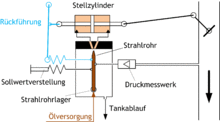Jet pipe regulator
A jet pipe regulator is a hydraulic modular regulator . The operating principle is based on the fact that an oil jet emerges from a pivoted nozzle tube, whereby the impulse of the oil jet acts on the piston surfaces of a hydraulic cylinder via receiver bores, depending on the jet overlap . The control deviation is formed by comparing the forces acting on the jet pipe. When the control is balanced, the nozzle pipe is in the middle position and both cylinder sides are subjected to the same pressure via the receiver bores that are equally covered by the oil jet. The cylinder is at rest.
The jet pipe controller works as a pure I-controller without any additional attachments - the actuating speed of the cylinder is almost proportional to the control deviation. A PT1 behavior can be achieved through add-on parts (return of the hydraulic cylinder position via springs to the jet pipe) . PI behavior can also be implemented via flexible feedback (dampers in the feedback circuit) . The setpoint specification can be applied by spring preload or by the force of an electromagnet ( plunger coil ). As a process signal, pressure can generate a force on the jet pipe via a corresponding diaphragm box. When used as a hydraulic booster or electro-hydraulic converter, the position of the actuating cylinder is returned to the jet pipe via springs.
The advantages of the nozzle regulator compared to other control devices of its era are its robustness, high actuating forces and diverse application possibilities. The Askania nozzle regulators developed by the Askania-Werke since 1923 are widespread . These provided a modular system that also enabled complex regulations to be implemented. In the 1950s and 1960s, the jet pipe controller was widely used in the power plant and process industry for almost all control tasks in the water-steam cycle, but also as a combustion controller or turbo compressor control.
Individual evidence
- ↑ a b Dipl.-Ing. Rainer Winckler: Oil-hydraulic control of turbo machines . Ed .: Continental Elektroindustrie Aktiengesellschaft, Askania-Werke Berlin-Mariendorf. Berlin 1960.
- ↑ Lothar Starke: From hydraulic regulators to process control systems - the success story of the Askania works in Berlin and the device and regulator works in Teltow . Berliner Wissenschaftsverlag, Berlin 2009, ISBN 978-3-8305-1715-3 , pp. 22-23 .
